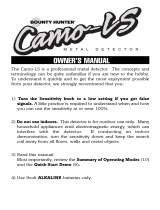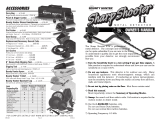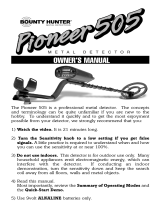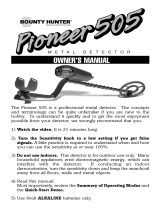Page is loading ...


TERMINOLOGY
The following terms are the common terminologies among the metal detector.
Motion Mode
Continuously moving the search coil is one of the circuit operation modes within the metal detector's built-in
detection technologies. You have to move the search coil during detecting -- preferably in a overlapping 'painting'
pattern. Generally speaking, motion detection mode can reduce the effect of misleading / unwanted soil mineralization
detection, and will have a better discrimination ability for more sought after findings.
Non-Motion Mode
This is your other metal detection option included within the detector's circuitry operation modes. When searching,
you need not move the search coil continuously, as long as your hover to locate and zero-in on your finding. When the
metal detector locates the object in non-motion mode, the detector cannot discriminate the metal categories -- in other
words, the discrimination levels do not function as in motion mode.
Elimination
To eliminate a particular metal while detecting is based on the user's preference. While searching the operator can
distinguish the specified metal, based on the metal detector's reaction to the search coil's response (a different sound in
tone and/or lighting indication can be differentiated). Please note, not all metal detectors feature a diverse and/or
wide array of detection elimination options and differentiation.
Discrimination
The detector creates sounds in different tones and/or gives different display and/or light indications to different metal
types. Discrimination also has the somewhat similar ability to also eliminate or 'zero-in' on the location/detection of
select metals. This is referred to as “discriminating”. Discrimination is one of the most important features of the metal
detector (a different sound in tone and/or lighting indication can be differentiated). Please note, not all metal detectors
feature a diverse and/or wide array of detection elimination options and differentiation..
Metals
The common metals are alloys, such as copper, due to the different character composition of different metals, they are
most generally divided and grouped by categories like: red copper, brass, bronze, etc. However, the same metals can
provide different detection / metal detector indication -- and vice versa, different metals can provide similar detection /
metal detector indication. With a same metal, due to the different composition, shape and differences in the degree of
oxidation, resulting in electrical conductivity or magnetic permeability are not the same, as in the metal detector, there
are more often different responses.
www.PyleAudio.com

Iron
Iron is a common metal, it’s usually not the dedicated detection target. Undesirable iron objects include iron nails,
bolts, old cans, caps, etc. Valuable relics and sought after materials can also be composed of iron, such as old
armaments, old armature, etc . So, it may be best to pay attention to everything you detect!
Ferrous Metals
It is the metal which is made of, or containing, iron.
Trash metals
Caps, pull-tabs, s-caps from beverage containers are the most bothersome trash items for treasure hunters while metal
detecting, you should wish, to preferably, eliminate them when searching and detection. But some other valuable
objects may have a magnetic signature similar to the above trash metals, and will also be eliminated when selecting
discriminating levels. Discriminate carefully and once again, it may be best to pay attention to everything you detect!
Pinpoint Targeting
Pinpoint targeting is the process of determining the exact location of a buried metal object. As in the motion detection
mode, you need move the search coil continuously when searching and it’s hard to determine the exact location of the
buried metals during pinpoint targeting. Using the non-motion detection technology, it allows the search coil to center
align with the location of the buried metal and narrow-down a more relevant and exact location of your finding.
Ground Balance
Because the metals and objects are buried in the earth, the mineralization that occurs in the soil will affect the
detection ability and signal frequency. The integrated ground balance detector technology will, to the best of it's ability,
eliminate or weaken the shielding effect of the mineralized soil. The ground balance system contains an internal
ground balance adjustment for regulation of such instances (a different sound in tone and/or lighting indication can be
differentiated). Please note, not all metal detectors feature a diverse and/or wide array of detection elimination options
and differentiation..
Note: when you initially power on the metal detector, the unit will go into the
self-inspection boot process. Do not press any buttons or perform any operations, until
the self-inspection program has been completed.
www.PyleAudio.com

Assembly
1. Open the packing box.
2. Loosen the locking knob on the lower stem, and loosen the bolt. Insert the lower stem to the search
coil, and tighten the connection. Don’t forget to insert the rubber gaskets on each side.
3. The control box attached to the arm stem handle with fasten screws at the bottom.
4. Press down the silver button on the upper arm and insert it to the other side of the middle stem.
www.PyleAudio.com

Assembly...
5. Make the silver button on the upper stem align at the two holes on the middle stem. Lock
the two triangle fasten screws at the bottom and affix the control box firmly.
6. According to the desired need, the user can align the silver button on the lower stem at a group of
holes on the middle stem, and adjust the length of the aluminum stem. Wind the cable of the search coil
around the aluminum stem, moderate tight / loose, so that the cable will not dangle, sway or interfere
when metal detecting.
7. Adjust the depth of the lower stem inserted to the middle stem. The bracket arm rest has three
position adjustments -- adjust accordingly. Release the triangle fasten screws under the bracket arm
when adjusting, Tighten the triangle fasten screws firmly when the desired height is set
www.PyleAudio.com

Battery
Make sure the unit is powered off when inserting or replacing the battery. Unscrew the battery cover and
place a 9V battery into the battery compartment, according to the battery polarity symbols. Replace the
battery compartment cover and make sure the rubber gasket is correctly placed to ensure a water tight seal.
Once the battery is inserted correctly, replace the battery cover. If you don’t use the detector for a long time,
please remove the battery from the battery compartment.
*Please note, factors including the size, angle and material of the target found, along with the composition
and type of the ground floor surface, will all affect the indication values.
Sensitivity Adjustment - Labeled 'SENS'
The sensitivity control knobs doubles as the power switch. Rotate the knob counter-clockwise until a slight
'click' is felt - indicating the power ON/OFF state of the metal detector. Rotate the knob clockwise to
increase sensitivity adjustment.
Generally, treasure hunters set sensitivity settings to the highest level, if there is much electromagnetic
interference around or the ground floor detecting surface is highly mineralized, the detector will sound an
erratic tone, and if this happens, then you should reduce the detector’s sensitivity. When the metal detector is
set in a higher sensitivity range setting, the detector will be sensitive to the electromagnetic interference that
comes from foreign or 'known' objects within the environment of detecting (ei. power lines, cables, pipes,
etc.). It is also possible to receive false metal detector readings from abnormal soil conditions, including the
mineralization of soil or electrical conductivity of the soil type. If you move the search coil in the detection
area,and the detector sends an unstable 'false' signal, decrease and adjust the sensitivity accordingly.
*When operating the metal detector, be sure to avoid close proximity with familiar and known metal objects
- as you intend to find unknown or hidden metal objects. The metal detector is also prone to interference
from electronic device and frequency wave generating technologies. Avoid electro-magnetic interference
and keep the unit away from cellphones, smart devices, TVs, computers, etc.
www.PyleAudio.com

Discrimination Adjustment - Labeled ' DISC'
Turning this adjustment knob counterclockwise will allow the metal detector to respond to all kinds of
metals. Rotating the DISC knob clockwise can adjust the discrimination capacity. When rotating in this
direction, the unit will reject the metals according to the conductivity of metals from low to high frequency
'foot-print' value. The reference sequence for discrimination is: iron, nickel, pull-tabs, zinc, brass and
aluminum.
*Silver cannot be eliminated by adjustment; the frequency footprint and composition detected is very
similar to aluminum so it may not be eliminated. According to the desired needs, you can choose the
different discrimination levels accordingly. Please note that when the ferrous metals are rejected by user
configuration adjustment, the detector may output an audible beep sound and the LED may light may
flicker.
When detecting a recognizable metal target, the LED light will flash and at the same time, the earphone, if
connected will sound a beep, frequency-receiving tone indication. The closer you metal detect, the more
powerful the LED flash will become -- as well as the louder the beeping frequency audible tone will become
*A continuously flashing LED light indicates the battery needs to be replaced, followed by an audible
'double beep' tone.
Motion Detection - 'Motion Mode'
When detecting using the moving 'Motion Mode', you should sweep the search coil at a constant (fairly slow
and steady) speed, and let the search coil remain parallel with the ground floor surface. Preferred height
distance of the coil from the ground floor surface is about 1/2 inches (1.5cm) directly above the ground
surface.
www.PyleAudio.com

Motion Detection - 'Motion Mode'
*For optimum metal detecting performance, never sweep the search coil as if it were a pendulum. Avoid
'angling' the search coil from the detecting ground floor surface.
Most worthwhile metal objects will provide a repeatable signal, if the signal will not be repeated when
hovering over, it is more than likely trash metals (or possibly over-oxidized materials). When a clear
sounding tone is heard, you can get a more approximate 'zeroed-in' location of your detected object.
Some practice and experience may be needed to develop the proper metal detector 'sweeping' style. Just like
your fingerprint, your sweeping / metal detector scanning movement will develop over time and will help to
optimize your metal detector's performance and your technique in general. If the search coil is swept too
slowly, the unearthed objects may not respond or be recognized by the metal detector -- the same goes if you
sweep too quickly past the objects. Another re-sweep or 'pass-over' can always help confirm the presence of
an existing metal but a unique and ideal sweeping style is what you're after. Proper scanning also involves
smooth, even swipes of the search coil, that includes overlapping already partially scanned areas as you
continue moving forward. Take the time to practice and experiment the ideal sweeping speed and style.
Learning, experimenting and discovering is all a part of the experience and you will gradually develop metal
detecting skills and sought-after habits over time.
Pinpoint your finding
When there is a clear signal to show you the location of the buried target objects, you can make an “X” scan
at this zone, generally the bottom of the intersection point is the target object.
Metal Detector Signals
*Most valuable metal objects detected will send repeatable signals, as you scan over the ground surface area
containing the object. If the signal is not repeated after your 're-scan' the ground floor surface area, it is most
likely a false signal. Hovering the search coil over the target object again can confirm the presence of a
metal object. Along with the LED light flicker visual indication, the metal detector will provide audible
frequency tones -- that also insist the presence of a detected metal object.
www.PyleAudio.com

Caution
In areas with heavy traffic, please do not wear earphones while detecting, in case an accident occurs.
Always obtain permission before searching any site.
Keep away from the areas that may have buried electrical or gas lines / cables.
Do not detect in private property, military owned areas or where you do not receive permission to detect.
When digging out the target, use a reasonable digging method that will not damage or cause harm to
yourself or any possible object within the surface area.
Try your best as to not destroy the vegetation, cause damage to any animals / insects.
Take care of mother nature!
Troubleshooting
SYMPTOM
SOLUTION
No power, there is no indication
There is no sound when powering on
1.Be sure battery is installed correctly.
2.Be sure battery cover is closed correctly.
3.Replace the battery.
Sound heard is an irregular tone, or the
target identification cursor chatters /
distorts
Make sure there are no electromagnetic interference sources
present, such as power lines, cables, electronic fences, etc.
Keep away from areas that are prone to cause interference or
you can reduce the detector's sensitivity.
The signal is unstable and the position
of the target identification cursor is
changing
1.Scan at a different angle, in order to determine whether you
can get a more stable signal.
2.If the target is buried deeply, you could try to increase the
sensitivity or speed up the search coil scanning speed, hovering
over the designated area. .
3.Maybe more than one metal targets are buried, you could try
to increase the sensitivity or set different discrimination ranges
when scanning.
4.Maybe you found a severely oxidated target, or the ground
contains some type of magnetic field or mineralized content.
Attempt to decrease the sensitivity and continue scanning.
www.PyleAudio.com

Part List
NO ITEM QUANTITY NO ITEM QUANTITY
1
Upper Cover A
of Headset
1 23 Battery Cover 1
2
Upper Cover B
of Headset
1 24
3 Ear Pad 1 25
Triangular Fasten
Button
2
4
Lower Cover
of Headset
2 26
Key Of Battery
Cover
1
5
Plate
2
27
Magic Stick Belt
1
6
Head Band
1
28
Upper Bracket
1
7
Support
2
29
Arm Support Pad
1
8 Headrest 1 30
Upper
Stem( Aluminum)
1
9
Metal Cover
2
31
V-shape Spring
2
10
LED
Lampshade
1 32 Stem Cover 1
www.PyleAudio.com

PHMD84
Waterproof Metal Detector, Adjustable Sensitivity / Discrimination, Headphones
Features:
• 100% Waterproof Metal Detection Performance
• Fully Featured and Easy-to-Use Metal Detector
• Locates Precious Metals & Treasures Buried
• Effectively Finds Gold, Silver, Iron, Coins, Jewelry and More
• Adjustable Discrimination & Sensitivity Level Controls
• Flashing Digital LED Light 'Hit' Indication
• Included Headphones Also Provide Audible 'Hit' Alerts
• Fully Disassembles for Portability & Storage
• Comfortable Arm Support and Adjustable Aluminum Stem
• Adjustable / Extendable Locating Arm Design (42'' - 52'')
• 7.8’’ inch, Concentric Waterproof Submergible Search Coil
• Includes Waterproof Headphones
• Headphone Jack (3.5mm)
• Automatic Ground Balance for Accuracy & Reliability
• Also Functions as Standard 'On-Land' Metal Detector
• Used on Shorelines, Beaches, Woodlands, Forests, etc.
• Locating Sensitivity: Max Depth 8.5'' inches
• Waterproof Safe in Depths up to 130'+ Feet
• Battery Operated: Requires: 9V Battery (Not Included)
• Low Battery Indicator
• Dimensions (L x W x H): 5.0'' x 10.2'' x 50.8''
• Weight: 5.3 lbs.
www.PyleAudio.com

/








